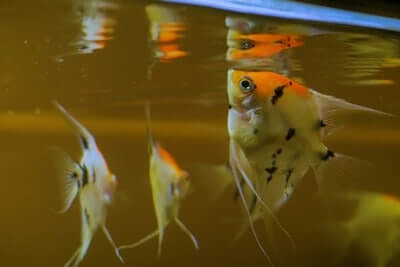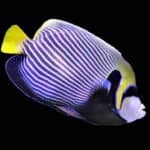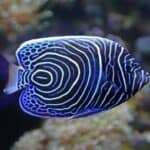Last Updated on: 16th November 2023, 01:29 pm
Angelfish are graceful creatures that appear calm and poised, so it’ll be obvious when they start gasping for air. Breathing fast is a bad sign, as angelfish only pant or gasp when struggling to breathe.
Angelfish breathe fast due to a lack of dissolved oxygen in the tank. When stressed or sick, their immune systems and gills function suboptimally, making breathing harder, hence the gasping.
The fish will suffocate if the tank’s pH level, nitrates, or temperature are incorrect.
When you notice these signs, aerate the water manually and replace around 15% of the unclean water. Also, use air stones or other devices to add air to the tank.
If your fish are overcrowded, you must separate the bigger and smaller ones.
How Fast Should Fish Breathe?
The breathing pattern of healthy angelfish is barely noticeable. You shouldn’t be able to tell when it is and isn’t breathing. Upon closer inspection, the inhalations and exhalations should be subtle.
Young angelfish breathe faster than adults because they can’t take in as much oxygen due to their size. However, young angelfish should behave normally despite rapid breathing.
Bad angelfish breathing includes:
- Breathing hard.
- Gasping for air.
- Opening and closing its mouth rapidly.
- Gasping at the surface of the tank.
- Breathing only at the surface.
What It Means When Angelfish Breathe Heavily
Heavy breathing and the signs above indicate that fish are suffocating. While angelfish can breathe water, they still need oxygenated water.
If there isn’t enough oxygen in the tank, or their body can’t process it, they’ll grow ill. As the oxygen deprivation continues, the fish may die.
Besides oxygen levels, angelfish breathe quickly when:
- Long-term stressed.
- Sick.
- Chased.
- In shock.
- Living in improper water conditions.
Reasons Why Angelfish Suffocate
Angelfish may only provide subtle indicators that they’re sick or struggling. You must rely on these signs and clearer indicators from their living environment.
Lack of Oxygen in The Tank
You may think your fish couldn’t possibly suffocate. After all, fish don’t breathe air because they breathe water, which is hydrogen and oxygen.
Fish breathe dissolved oxygen, not pure oxygen.
In nature, oxygen from the atmosphere gets dissolved in water by pouring over rocks. Cold water has more oxygen than warm water, so rapidly moving bodies of water contain more oxygen than still bodies.
If the aquarium water has no movement to fill it with oxygen, it’s deadly to the angelfish. They will start to suffocate. You also can’t rely on the fish’s ability to take oxygen from the surface of its tank. This will keep it alive for a while.
Fish breathe by taking in water through their mouths, which passes through the gills. The dissolved oxygen in the water makes it to the fish’s red blood cells through the blood vessels.
Fish don’t have the bodily functions to take in pure oxygen and have it travel to the bloodstream like humans. If you take a fish out of the water, it won’t be able to breathe.
The only way for it to acquire oxygen is if a liquid transports it through the blood vessels.
Here’s how to tell if an angelfish lacks oxygen in the tank:
Slow Swimming
When taking in oxygen, an angelfish’s cells perform aerobic breathing.
This is when oxygen molecules are converted into cellular energy. When angelfish don’t have enough oxygen to convert into energy, they become lethargic. They’ll swim very slowly as if they’re tired.
Gulp For Air At The Surface
More dissolved oxygen is at the water’s surface than below, which may keep the fish alive for some time. Eventually, they run out of oxygen and die.
What if your angelfish is at the bottom of the tank?
It means the fish has no energy to swim to the surface and is close to death. The oxygen levels are lowest at the bottom of the tank due to all the waste.
This is the last place an angelfish would want to be if it was suffocating.
Discoloration
Angelfish change colors often for positive and negative reasons. When suffocating, an angelfish’s color will slowly fade.
Angelfish change and maintain their color through a cellular process that requires energy. The color of a suffocating angelfish fades because the body no longer has the energy to maintain its color.
Opening And Closing Mouth
The first step for fish breathing is taking in water through the mouth. Breathing is proving difficult if an angelfish opens and closes its mouth repeatedly.
Lack Of Appetite
A fish that’s slowly suffocating won’t be interested in food.
The body will also reserve as much energy as possible to keep the angelfish alive. Anything that requires extra energy, like eating and digesting food, will be low on their list.
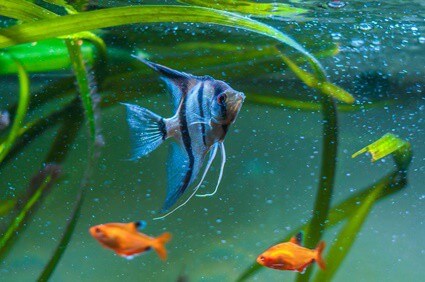
Swimming Near The Filter
Some aquarium filters release a lot of bubbles, which contain oxygen. If angelfish swim near the filter, it’s the only place they can get oxygen.
Water Tests
Testing the oxygen levels is the most effective way to know if your fish lack oxygen.
There are two ways to test the oxygen levels:
- A chemical test kit.
- A portable dissolved oxygen meter.
A portable dissolved oxygen meter costs more than a chemical test kit, but the results are more accurate.
| Survivability | Dissolved Oxygen Levels (milligrams per liter) |
| No chance of survival | 0-4.0 mg/L |
| Very few fish can survive | 4.0-6.5 mg/L |
| Some big fish might survive, but small fish won’t | 6.5-9.5 mg/L |
| All fish can survive | 9.5-12mg/L |
Long-Term Stress
Stress benefits angelfish by giving them the adrenaline needed to escape dangerous situations.
However, long-term stress due to constant exposure to threats can compromise angelfish’s immune system, interfering with their breathing ability.
The signs of stress in an angelfish include:
Lack of Appetite
If the angelfish fears it’s in danger, it won’t eat, so it can focus on avoiding the threat. It may gasp as it feels stressed and is low on energy due to a lack of food.
Avoidant Behavior
This usually happens when a tank is overcrowded. If there are too many fish, it’ll try the following:
- Swimming to a secluded area of the tank.
- Hiding behind plants.
This also happens when other angelfish are in the middle of trying to acquire mates. They’ll establish dominance over the other fish or fight to claim territory.
If one angelfish doesn’t feel up to the possible fights, it’ll get stressed while protecting itself. This added danger makes it difficult for the fish’s body to breathe easily.
Aggressive Behavior
Stress can make angelfish lash out. When they feel cornered, some angelfish will attack other fish since they have nowhere to go.
In their natural habitat, angelfish will swim as far away from danger as possible. That option isn’t available in small aquariums as the stress will affect their ability to process air.
Lethargic Swimming
Sudden movements from a human outside the tank or a tankmate can stress angelfish.
It’ll feel in danger and begin swimming quickly to avoid the threat. Not only is this exhausting, making the fish breathe harder, but it compromises its body.
In tandem, the fish will quickly get tired out. Slow swimming is a sign of long-term stress.
Rapid Changes In Color
Angelfish change color depending on the illumination of their environment. If the lights are low, their color will fade, and if the lights are bright, the scales will also get brighter.
Light levels change faster in a house than in an angelfish’s natural environment. A room can become brighter with the flick of a light switch, and this rapid environmental change can stress angelfish.
Pale Stripes
When hiding from a predator, angelfish will often hide behind plants and fade the color of their stripes.
If the stripes fade for a few days, the angelfish has long-term stress. You’ll notice the fish gasping or ‘panting’ as a result.
Improper Water Conditions
Apart from oxygen, angelfish will become stressed because they lack:
- pH levels.
- Nitrate levels.
- Nitrite levels.
- Ammonia levels.
If it goes on for long enough, the fish will eventually suffocate.
Certain chemicals can also harm the angelfish’s gills, making it harder for them to breathe. Check the gills for any sign of redness or discoloration.
Regularly test the water and make sure everything is balanced. Sometimes, angelfish won’t show the symptoms of stress quickly enough for you to do something about it.
Injury And Illness
Any illness or injury is taxing on an angelfish’s body. Certain illnesses compromise the function of the gills, making it hard for angelfish to breathe.
Here are some signs your angelfish is ill or injured:
Bloat
If an angelfish’s stomach looks rounder than usual, it’s likely bloated. This can be because of overfeeding, bacteria, constipation, pregnancy, or tumors.
Raised Scales
Certain diseases can cause the scales on a fish to lift and protrude from the body. These diseases usually affect the gills to a heavy degree.
Torn Fins And Cuts
Depending on how badly the angelfish is injured, physical wounds take a lot of time and energy to heal.
As the body prioritizes healing, an angelfish’s breathing can become labored. However, this mostly happens with angelfish that are gravely injured.
Being Chased By Tank Mates
Fish are opportunistic. Even when there is plenty to eat, they can still turn cannibalistic. When a fish in the tank is dying due to injury or disease, the other fish will react.
This is often with nibbling and chasing. The stress of running from other fish and fleeing may cause the fish to breathe heavily.
Discoloration
Just like humans turn a different color when they’re physically ill, angelfish will change the color of their scales when sick.
It depends on how healthy the angelfish was before getting injured or sick.
Usually, the discoloration begins with the angelfish’s original color dulling. When the angelfish is near death, the color gets paler. This will be accompanied by heavy breathing.
Why Is My Angelfish Breathing Fast After a Water Change?
Changing the water in a tank can be complicated, especially for first-time owners. Still, changing the water every 2-4 weeks is necessary to keep the environment clean.
When doing so, consider each element carefully. If you miss one aspect of the water change, you can make your fish struggle to breathe.
Here are points you may have missed:
Temperature
The temperature of an aquarium must remain between 78 and 83 degrees Fahrenheit.
If the newly added water is warmer or colder than the current water, it could shock their system and cause them to breathe faster.
Always check the water temperature and match that temperature to the new water.
Salinity
Test the amount of salt in the water. Aquarium salt can be used to treat the water for diseases. However, the more salt there is, the less dissolved oxygen is in the water.
Most pet angelfish are freshwater or don’t need a lot of salt in their water. However, adding some aquarium salt helps rid the tank of germs.
The amount depends on the tank size and the number of fish.
Debris
The fish may have breathed in debris while changing the water and cleaning the tank, like gravel or sand.
Besides frequently changing the water, the bottom of the tank should be cleaned, and the gravel should be replaced occasionally.
Chemicals
Always make sure that the new water you add to the tank is:
- Filtered.
- Matches the chemical levels of the water in the tank.
The new water should also neutralize any pathogens, metals, and bacteria.
Water Change Schedule
When you change the water, it’s crucial to have a strict schedule.
Your angelfish may get too accustomed to the water they swim in. Then, no matter how badly it needs to be cleaned, the old water is essential to their survival, as new water might send them into shock.
To avoid this problem, be sure to change the water regularly. Don’t let it get too dirty.
It’s also important not to change the water too frequently, as this stresses them. By setting a fixed schedule, you can be sure to avoid issues.
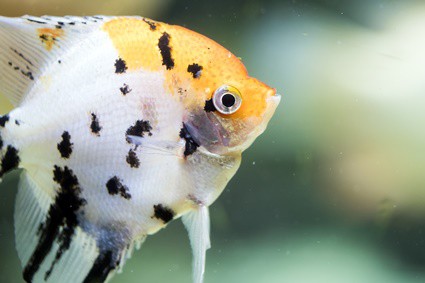
How To Increase Dissolved Oxygen in an Aquarium Without a Pump
Traditionally, people use water pumps to aerate the water in their fish tanks.
This creates a flowing current, which helps dissolve oxygen in the water. However, sometimes a water pump isn’t readily available. It may also fail to solve your problem fast enough.
If a pump is out of the question, you have other options.
Here are emergency solutions, as well as long-term solutions:
Quick Solutions
If the angelfish are suffering, it’s best to act fast. Take these steps to get them out of immediate danger.
Increase airflow
If the aquarium has a lid, open it and expose the water to air.
Aerate The Water
This can be done by increasing the water movement, as still water doesn’t move fast enough to dissolve oxygen. You can temporarily help by making waves in the water and moving it around:
- Take a clean glass container.
- Begin taking water from the tank.
- Pour it back in from up high.
The splashes will create enough movement to begin trapping oxygen in the water. The movement will help dissolve the oxygen and give your angelfish what they need.
Change The Water
For a slightly more long-term fix, change the water. You should replace 15% of it with fresh water that (most likely) has more oxygen than the present water. This will:
- Fix the issue for now.
- Help stir the original water and give it more oxygen.
Be careful with this method, as the change might upset the fish more if:
- You recently changed the water.
- The fish are under too much stress from an already inadequate environment.
Remove Waste
Dissolved oxygen levels are low at the bottom of the tank. That is because it’s where you’ll find the most:
- Bacteria.
- Spoiled food.
- Waste.
- Algae.
All these materials use up oxygen. By removing the waste, you can increase the overall dissolved oxygen levels of the tank.
Long-Term Solutions
The fish will eventually suffer again if the aquarium isn’t completely fixed. To ensure the fish have an appropriate environment to thrive in, apply these changes:
Change The Oxygen Levels Adequately
The bigger the fish, the more oxygen they utilize. This is why smaller fish breathe faster than bigger fish, as they take in smaller amounts of oxygen due to their size.
If you have a tank full of juvenile angelfish, you should increase the dissolved oxygen levels as they grow. The angelfish may be okay with the dissolved oxygen levels while they are small.
Air Stone
Air stones are small machines you place at the bottom or side of the tank. They release continuous bubbles that help dissolve oxygen and create small waves. They are:
- Inexpensive.
- Easy to install.
- Ideal for aquarium owners with smaller tanks.
Add Aquarium Plants
Aquarium plants take in carbon dioxide and release oxygen. Angelfish like:
- Water wisteria.
- Java ferns.
- Water sprites.
- Java moss.
The downside is that the plants need to be looked after. Otherwise, they’ll decay. If this happens, the plants will become nothing but waste at the bottom of the tank, taking up oxygen.
Add A Waterfall Filter
Adding a waterfall filter creates waves and aerates the water. Ensure the filter isn’t too strong and creates a fast current.
Angelfish are native to the rivers of South America and aren’t accustomed to swimming in fast currents. If the filter creates a tank environment where the fish must swim faster, they’ll have trouble breathing.
Change The Type And Number Of Fish in The Tank
You may need to look into the type of fish that live with your angelfish. That’s especially true if you own species of differing sizes.
Bigger fish always take up a lot of oxygen. You may have to separate the angelfish from the bigger ones by putting them in separate tanks or rehoming them.
Energetic fish that swim quickly around the tank will also take in more oxygen. The rapid movement may startle the angelfish and stress them out, leading to breathing problems.
Angelfish should never breathe fast. If they do, check their environment, tankmates, and health.

